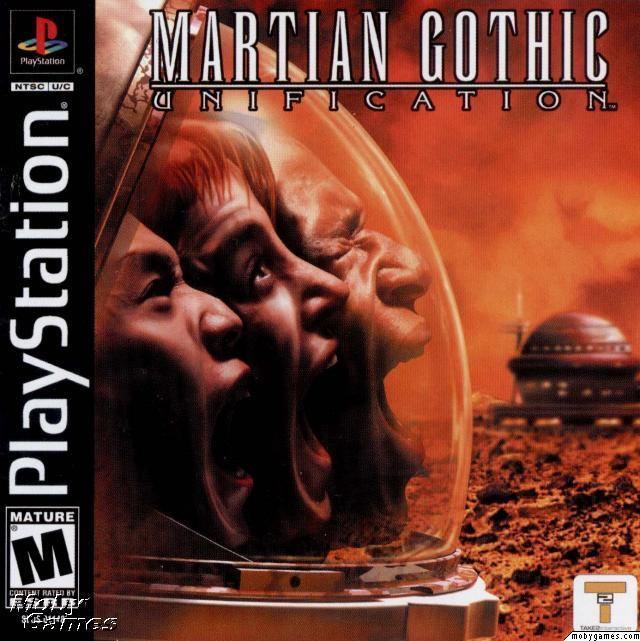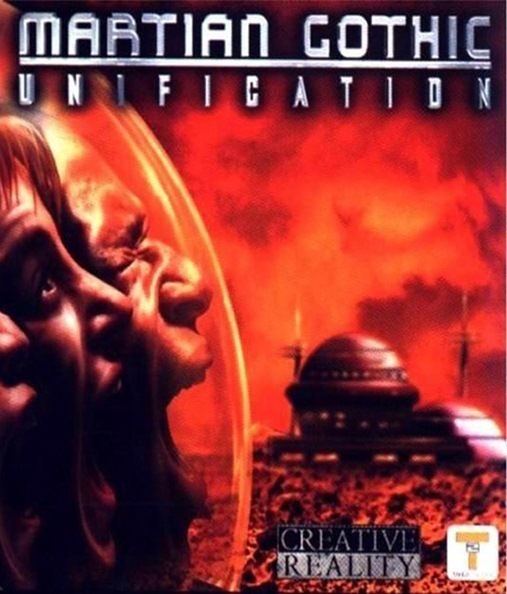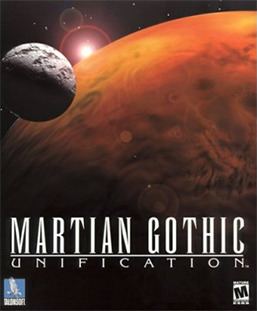6.4 /10 1 Votes6.4
Composer(s) Jeremy Taylor Initial release date 2000 | 64% Metacritic Developer Creative Reality | |||||||||||||||||||||||||||||||||
Programmer(s) Neil DodwellMartin Wong Artist(s) David DewJulian HoltomPaul Oglesby Publishers Similar Take-Two Interactive games, Survival horror games, Other games | ||||||||||||||||||||||||||||||||||
Super replay martian gothic unification episode 1
Martian Gothic: Unification (also known as just Martian Gothic) is a survival horror video game developed by Creative Reality for Microsoft Windows and Coyote Developments for the PlayStation and published by TalonSoft for Microsoft Windows and Take-Two Interactive for the PlayStation. The PlayStation version was one of a number of "budget titles" released near the end of the system's lifespan.
Contents
- Super replay martian gothic unification episode 1
- Gameplay
- Setting
- Story
- Kenzo Uji
- Martin Karne
- Diane Matlock
- MOOD
- Enemies
- Development
- Reception
- References

Gameplay
The game is very similar to the Resident Evil series: third-person perspective; fixed camera angle; tank controls; “Vac-Tubes” in the place of item boxes; and colored key-cards. The game focus heavily on puzzle solving and exploration, rather than combat. However the combat system focuses on crowd control or dispatching small and weak enemies as it is easy to become overwhelmed by enemies such as the non-dead who walk at exactly the same pace as the player. The game is centered on three playable characters that are separated. This separate trio gimmick is similar to Day of the Tentacle. One of the unique features of the game is that if the characters ever meet face-to-face, it will result in a game over. However the player can easily and quickly switch to any character at any moment. A radio is used for easy communication. It is recommended that the player finds a ‘safe area’ before switching characters. The characters have a very limited inventory. Because the characters cannot meet they can trade items using the Vac-Tubes that are scattered throughout the base. The Vac-Tubes can carry up to four items to another hatch connected to the Vac-Tubes anywhere in the base. If the player needs to leave behind items the Vac-Tubes can hold up six items. If the player is unsure where they left an item, it can be checked using any in-game computer to bring up the list of contents of any hatch, including ones that have not been accessed yet.

The purpose of the game is to unravel the events before the characters arrival. To do this the player may search dead bodies for letters or micro-recorders which may contains information about the character, plot, passwords, and the method in which they might have died. Many recordings have been stored on some of the base’s computers, which also contain information about the characters, plot and further the player’s progress.
Another unique feature of the game is that the non-dead enemies cannot be killed permanently. Shooting an enemy enough times will incapacitate it temporarily, but it will reanimate if the player re-enters the area later and comes to close to the enemy’s fallen model.

Saving is done through a computer game called "Martian Mayhem" and is limited to 2-4 saves in the PC version and 12 saves in the PlayStation version. Once the player reaches the Necropolis excavation site, a laptop is found that allows the player to save anywhere.
Setting
In Martian Gothic, the player is able to assume the role of three characters sent from Earth to a Martian base called Vita-01. The base was the first human settlement on Mars. The team have been sent to examine why it has been silent for ten months. The last broadcast from the base simply stated: “Stay alone, stay alive.” Upon arrival the player finds that all the residents are apparently dead and must gradually uncover the secrets and nature the last undertaking by Vita-01's crew; the discovery of ancient Martian "Pandora's Box" which, when opened, started a chain of chaotic events that led to the base's downfall, and death of almost all of its inhabitants. However, during the player's progress of uncovering the truth, searching for any possible survivors, and solving Vita-01's many mounting problems, the player finds that the dead crew have become re-animated as non-dead and begin attacking the player. When the player enters the base each character states that the decontamination process felt wrong. The three characters must not meet due to a threatening alien presence that would cause them to mutate into a “trimorph” if they did.
The Vita-01 base was constructed in 2009 by the Allenby Corporation, implied to be Earth's most powerful megacorporation, to research potential alien life from microfossils on Mars, after discovering in 1996 that a Martian meteorite found in 1984 contains ancient bacteria which had crashed in Antarctica in 11,000 BC. Vita 1 is situated very close to Olympus Mons which can be partially visited by the player upon access to the underground "Necropolis" zone, the human-excavated ruins of an old Martian city of Vita-01.
Story
Taking place on the 17th June 2019, ten months after Vita-01’s last broadcast to Earth with the message “stay alone, stay alive” on 8 August 2018. The investigation team of Kenzo Uji, Martin Karne, and Diane Matlock approach Vita-01 on Mars in their spacecraft. Vita01’s main computer MOOD appears to have noticed their arrival. Kenzo is forced to make a crash landing on the Martian surface and its crew depart into different airlocks of Vita01. MOOD apathetically predicts that, although the three have entered only two will leave alive. The trio are separated and obtain radios from their spacesuits to stay in verbal contact. All three go through decontamination, but each notes that there was something wrong with the decontamination. Initially only Kenzo can enter the base as Karne and Matlock’s airlock doors are sealed. Kenzo stumbles upon various dead bodies in the silent hallways, including the corpse of the base’s leader, Antonio Fellicci. By listening to the recording found on his corpse, Kenzo discovers that Vita-01’s downfall came when the people started shooting at each other in the base hallways. Kenzo finds Fellicci’s room but finds a dead body supernaturally levitating in the hallway. Using Fellicci’s computer, Kenzo unseals the door to Karne’s airlock. However once the door is unlocked the dead body of Fellicci’s girlfriend re-animated and tried to attack Kenzo.
Karne exit his airlock and enters the base in a different area than Kenzo. Not long after traversing the hallways, Karne notices that his watch only displays the impossible time of 48:62. It is a passcode to a nearby hatch- this, along with other various small events are the work of MOOD trying to help the three survive. Using the passcode discovered by Kenzo, Karne enters the arboretum, obtains a gun form a corpse, and encounters a Trimorph, which blocks the way to the recycled oxygen treatment room.
Kenzo Uji
Wataru Arai
Kenzo describes himself as a “techno-zen hippy.” He is the info-mesh specialist (a virtual man-machine interface). Because of this he is the only one able to fully interact with MOOD. Despite the dire situation on the Vita-01 base, Kenzo remains an extremely calm and detached person. Kenzo is the first to reach MOOD’s chamber and find access cards for Karne. Later he spends most of his time in the infor-mash reality managing the base’s systems. He is the only one who can use the Psionarra, an experimental psychic gun that is found late in the game. Because of his strange occupation, Kenzo never show any sign of emotion and has strange one-liners. His voice actor was actually Japanese and was not a professional voice actor.
Martin Karne
Rupert Degas
Karne is the teams security expert. He is an ex-covert ops agent and former friend of Allenby. His son died during a tragic accident. He is a natural leader and is given the most objects out of the playable characters. Contrary to the others, he signed up because of personal reasons. Karne seems to be surrounded by secrets. By exploring Vita-01, Karne’s secrets will be revealed. Karne acts very cynically and cracks grim jokes. He does not have a special skill but he solves many puzzles.
Diane Matlock
Anita Dashwood
Matlock is a microbiologist and is acting as the scientific expert for the team. She hides her fear behind a happy-go-lucky attitude. She is the most knowledgeable about Vita-01 and its crew. During the game she makes regular comments about the past lives of the corpses and non-dead. Matlock is very useful once the player reaches the lab section. She can synthesize health kits and antidotes from herbs with the proper equipment. Unfortunately she starts the game trapped in an airlock. It takes a few hours to get her out.
MOOD
Fenella Fielding
She is the sentient info-mesh in charge of handling Vita-01’s massive network systems. As an A.I., MOOD only appears as a rainbow like wall materializing as sound-waves. In direct response to the events taking place on Vita-01 she locks most of the blast doors. Kenzo has to convince her to open them. Kenzo can access her mainframe through a virtual representation of his traditional Japanese home. MOOD is always testing the characters and the player. For unknown reasons, she deeply resents Martin Karne.
Enemies
Non-dead
This is the most common enemy threat. The non-dead is a corpse reanimated by an alien presence. They sometimes activate when the player walks near one of their corpses. They cannot be permanently killed. As the game progresses the non-dead will rise faster after being shot down. All non-dead carry recovery items, logs and puzzle items.
Extrude
These are annoying little creepers who can easily overwhelm the player. They come in three different versions, each has a different color. They will jump at the characters face, either spitting poison or paralyzing the player.
Trimorph
The origin of the “stay alone, stay alive’ tagline these are hulking brutes that cannot be killed through normal attacks. These can be killed by solving puzzles.
Development
The game was one of numerous "budget" titles that came out at the end of the PlayStation lifespan. This was Creative Reality’s last game. The game shares the same team and same writer as Dreamweb, as such it heavily relies on writing and puzzles. In an interview with Stephen Marley with Retroaction Magazine, he stated that he was unhappy with the final product. in this interview it was revealed the game was based on point and click adventure games but grew out of this idea. the game was changed to a survival horror game but it kept many of the item based puzzles from its original concept. There was a significant downgrade of textures on the PlayStation version. The PlayStation version also allowed the player to save more.
Reception
Martian Gothic: Unification was met with mixed reviews. Aggregating review websites GameRankings and Metacritic gave the PlayStation version 64.75% and 64/100 and the PC version 58.65%. IGN gave the game 7.9/10 stating that it had "a lot to offer...the story -- though seemingly cobbled together from many different sci-fi plots -- is engaging and keeps you guessing." Steve Smith from GameSpot stated the game was a "missed opportunity’ as the designers had good ideas but did not mix the game elements into a balanced game." One of more positive reviews came from PlayStation Illustrated, who gave the game 8 out of 10.
